
The Pennsylvania wood cockroach or Pennsylvanian cockroach is a common species of cockroach in eastern and central North America.

Parcoblatta virginica, the Virginia wood cockroach, is a small cockroach species of the genus Parcoblatta, measuring about a centimeter long as an adult.
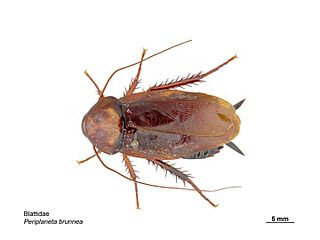
The brown cockroach is a species of cockroach in the family Blattidae. It is probably originally native to Africa, but today it has a circumtropical distribution, having been widely introduced. In cooler climates it can only survive indoors, and it is considered a household pest.
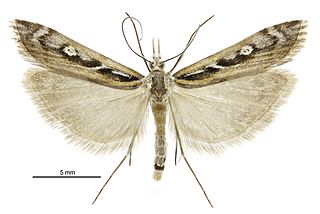
Kupea is a monotypic moth genus of the family Crambidae described by Alfred Philpott in 1930. It contains only one species, Kupea electilis, also known as Kupe's grassmoth, which is endemic to New Zealand. This species has only been recorded at Kaitorete Spit. The larvae feed on Zoysia minima and exist in a cocoon constructed of silk and sand. Adults are on the wing from March to April. It has been hypothesised that the adults are active at twilight. It is classified as Nationally Vulnerable by the Department of Conservation. The female of the species was first discovered in 2012.

Ichneutica insignis is a moth of the family Noctuidae. It is endemic to and found throughout New Zealand, although it appears to be scarce at inland sites of tussock grasslands. The adults are on the wing throughout the year. It is a variable species and as such can be easily confused with I. skelloni and I. plena. The larvae of this species have been recorded as feeding on Trifolium pratense.

Campbellana is a genus of moths of the Carposinidae family, containing only one species, Campbellana attenuata. This species is endemic to the Campbell Islands of New Zealand.
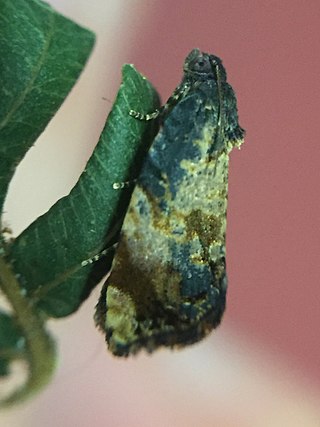
Philocryptica is a monotypic genus of moths belonging to the subfamily Tortricinae of the family Tortricidae. It contains only one species, Philocryptica polypodii, the leather-leaf star-miner, which is endemic to New Zealand. This species has been recorded in both the North Island and the South Island, as far south as Banks Peninsula. The preferred habitat of this species is native forest where the species' larval host is present. The larvae feed on Pyrrosia eleagnifolia, mining the host plant leaves. P. polypodii pupates within the final blotch-mine. Adults are on the wing in November and December.

Drymaplaneta semivitta is a species of cockroach native to Australia and introduced to New Zealand. In New Zealand, it is known as the Gisborne cockroach, after the city of Gisborne where it was first discovered in the country. It has also been claimed to have first appeared in Tauranga in 1954, probably arriving on a log shipment.

Glyphipterix achlyoessa, commonly known as the cocksfoot stem borer, is a species of moth in the family Glyphipterigidae. It is endemic to New Zealand and can be found throughout the country. This species inhabits meadows and open grasslands. The larvae are hosted by species in the genus Juncus as well as by the species Dactylis glomerata. Adult moths are commonly on the wing from October to December.

Mnesarchella loxoscia is a species of primitive moth in the family Mnesarchaeidae. It is endemic to New Zealand. and is found in the Northland, Auckland, Coromandel, Waikato, Bay of Plenty, Taranaki, Taupo, Gisborne, Rangitikei, Wellington and the Marlborough Sounds regions. Adults of this species are normally on the wing from December and January but can be on the wing as early as October.
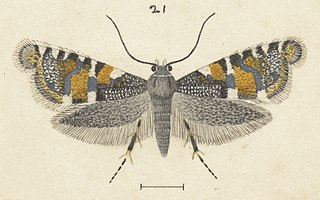
Glyphipterix euastera is a species of sedge moth in the genus Glyphipterix. It is endemic to New Zealand. This species is classified as "At Risk, Naturally Uncommon" by the Department of Conservation.

Polyzosteria is a genus of around sixteen species of cockroaches in the Blattidae family native to Australia. Some of these insects are attractively marked, such as Polyzosteria mitchelli. The type species of the genus is the Botany Bay cockroach, Polyzosteria limbata.

Drymaplaneta heydeniana is a species of cockroach.
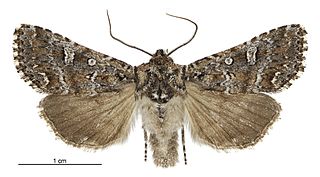
Ichneutica lithias is a moth of the family Noctuidae. This species is endemic to New Zealand. It is a small moth but distinctive as a result of the markings on its forewings. Although this species is widespread in the South Island, it has only been collected in the Rangipo Desert in the North Island. The species prefers habitat that is scrubland ranging in altitude from coastal to alpine. Adults are on the wing from October to April and larvae have been collected and reared on the New Zealand endemic plant species Melicytus alpinus.
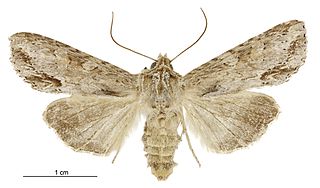
Ichneutica mollis is a moth of the family Noctuidae. It is endemic to New Zealand and is found from the Coromandel peninsular and Mount Te Aroha southwards including in the South and Stewart Islands. It lives in a variety of habitats including mountainous beech forest, podocarp forest and also grasslands. The larvae feed on grasses and herbs. The adults of this species are on the wing from October to March and are attracted to light and feed on blossoms.

Ichneutica omoplaca is a moth of the family Noctuidae. It is endemic to New Zealand. It is widespread from the Bay of Plenty in the North Island down to Southland in the South Island. Specimens have also been collected from the Auckland Islands. It lives in a variety of habitats including beech forest clearings and tussock grasslands. This species has been recorded that some of the larval hosts of this species include Poa cita, Dactylis glomerata and it has been reared on Plantago lanceolata. The larva is undescribed but pupae have been found in a pine plantation in soil under weeds. Adults of this species are on the wing from October to March. The adult moths are variable in appearance but the diagnostic feature is the pale ochreous to white colouring between the basal streak and the costa which contrasts with the ground colour of the forewing.
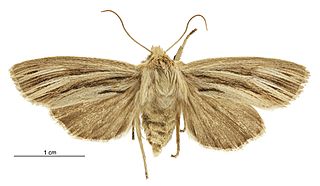
Ichneutica stulta is a moth of the family Noctuidae. It is endemic to New Zealand. This species has only been collected from West Plains and Tuturau in Southland but, as at 2021, no male species appears to exist in collections. I. stulta can resemble I. acontistis but can be distinguished as I. stulta has a strongly curved forewing edge as well as having a discal spot on the underside of the hindwing. I. stulta is also darker than specimens of I. acontistis obtained in the southern parts of the South Island. I. stulta is also very similar in appearance to I. emmersonorum but the later species has darker forewings and is more strongly marked on the thorax. The life history of this species is unknown as are the host species of the larvae but the adults have been recorded as being on the wing from October to December.

Lysiphragma argentaria is a species of moth in the family Tineidae. It is endemic to New Zealand. It is classified as "At Risk, Naturally Uncommon" by the Department of Conservation.

Pseudocoremia lupinata is a species of moth in the family Geometridae. It is endemic to New Zealand and can be found in both the North and South Islands. The favoured habitat of this species is Kānuka scrubland as its larval hosts are species in the genus Kunzea. Both the larvae and adults of this species are nocturnal. Adult moths are commonly on the wing from December to June and are attracted to light.
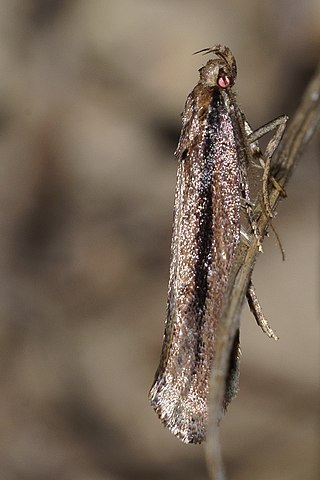
Atomotricha versuta is a moth in the family Oecophoridae first described by Edward Meyrick in 1914. It is endemic to New Zealand and has been observed in both the North and South Islands. The adults of the species are variable in appearance but the three principal variteis are connected b intermediate forms. The female of the species is brachypterous and is incapable of flight. Both the adult male and female have been observed resting on fences during cold winter nights.




















